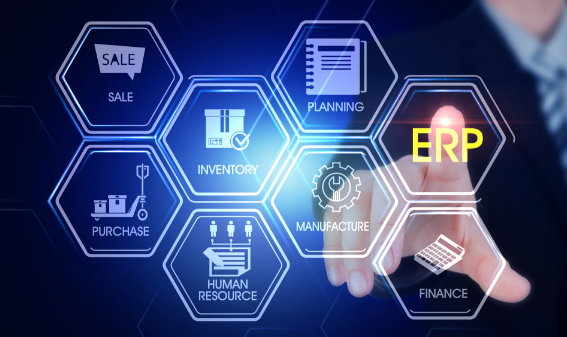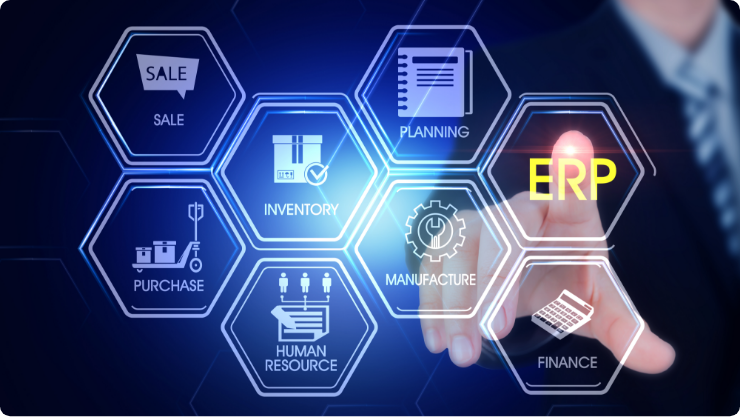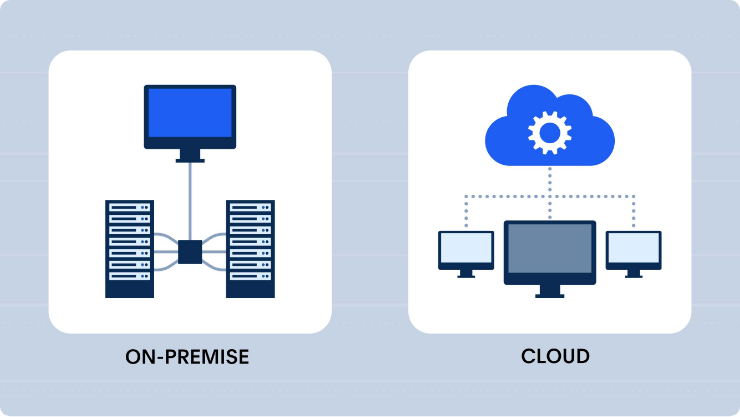What is Enterprise Resource Planning (ERP)?
Everything you need to know about Enterprise Resource Planning, presented by Replicon, the Time Intelligence® platform.

- What is Enterprise Resource Planning (ERP)?
- What is an ERP System?
- Business Benefits of Enterprise Resource Planning (ERP)
- ERP Solutions Providers
- Fundamentals of ERP
- What’s the Difference Between ERP and Financials?
- History of ERP
- ERP Deployment Models
- Pros and Cons of On-Premises & Cloud ERP
- Best-Of-Breed Time Tracking for ERP
- Boost Business Productivity With Robust ERP Systems
- What is Enterprise Resource Planning (ERP)?
- What is an ERP System?
- Business Benefits of Enterprise Resource Planning (ERP)
- ERP Solutions Providers
- Fundamentals of ERP
- What’s the Difference Between ERP and Financials?
- History of ERP
- ERP Deployment Models
- Pros and Cons of On-Premises & Cloud ERP
- Best-Of-Breed Time Tracking for ERP
- Boost Business Productivity With Robust ERP Systems
As businesses grow and evolve, the limitations of simple operational planning software, such as spreadsheets, become apparent. With increasing demands and complexities, organizations often find themselves in need of a comprehensive solution that can address a multitude of operational requirements.
Enter enterprise resource planning (ERP) software – the game-changer that enables organizations to gather and structure vital business information, facilitating lean and efficient operations even amidst expansion.
But while the term “ERP” is familiar to many professionals, its full potential might still remain a mystery. In this comprehensive blog, we’ll explore what exactly an ERP system is and how it can benefit organizations. Then we’ll dive into the details, explaining how ERP works and how it helps businesses streamline operations, improve efficiency and foster growth.
What is Enterprise Resource Planning (ERP)?
Enterprise resource planning (ERP) is a robust software system that empowers organizations to efficiently streamline and automate their essential business operations. ERP software provides a comprehensive platform for managing day-to-day activities and fostering operational excellence.
How does it do that?
By integrating a wide range of functions, such as accounting, procurement, human resources, and supply chain management.
With real-time data synchronization, process coordination, and centralized reporting capabilities, ERP enables companies to optimize performance, enhance decision-making, and drive growth across various facets of their enterprise.

What is an ERP System?
An ERP system provides a complete suite of applications and tools designed to support and automate various functional areas of an organization. At its core, an ERP system acts as a digital backbone for the organization.
It does so by enabling the seamless flow of information and facilitating collaboration across different departments and stakeholders. To ensure this, it consolidates data from various sources into a unified database. This provides real-time visibility and insights into streamlining business operations.
Business Benefits of Enterprise Resource Planning (ERP)
Implementing an ERP system can bring several significant business benefits that contribute to improved operational performance and enhanced competitiveness for organizations across various industries.
Here are some key benefits of ERPs:
Streamlined Operations
ERP integrates and automates business processes, eliminating manual tasks, reducing duplication of efforts, and improving overall operational efficiency.
Improved Productivity
With streamlined processes, employees can focus on value-added activities rather than manual data entry or redundant tasks, leading to increased productivity and output.
Enhanced Data Visibility
ERP provides real-time access to data across departments, which is accurate and comprehensive. This enables better decision-making, data analysis, and reporting.
Efficient Resource Management
ERP optimizes the allocation and utilization of resources, such as inventory, equipment, and personnel, reducing costs and enhancing resource planning and utilization.
Integrated Information
ERP eliminates data silos and ensures data consistency and integrity across the organization, enabling seamless collaboration, communication, and information sharing.
Enhanced Customer Service
With a centralized customer database and integrated processes, ERP enables improved customer relationship management, including faster response times, personalized services, and better order fulfillment.
Regulatory Compliance
ERP systems often incorporate features to assist with regulatory compliance, ensuring adherence to industry-specific standards, financial regulations, and data privacy requirements.
Scalability and Growth
ERP systems are designed to accommodate organizational growth and expansion, providing flexibility to adapt to changing business needs, add new functionalities, and support increased transaction volumes.
Cost Savings
By streamlining processes, reducing errors, optimizing inventory levels, and improving resource utilization, ERP can result in cost savings and operational efficiencies.
Competitive Advantage
Implementing ERP provides a competitive edge by enabling organizations to operate more efficiently. It also helps with making data-driven decisions, and responding quickly to market changes & customer demands.

ERP Solutions Providers
ERP solution providers offer a range of options to organizations seeking effective ERP implementations. Companies like SAP, known for its comprehensive suite of software modules, provide scalable and integrated solutions across various industries. Oracle’s ERP offerings, including Oracle ERP Cloud, cover finance, supply chain management, and more.
Microsoft’s Dynamics 365 integrates finance, operations, sales, and customer service seamlessly. These reputable providers, among others, bring industry expertise, tailored functionalities, and scalability to help organizations select, implement, and maximize the benefits of ERP solutions based on their unique requirements and business objectives.
Fundamentals of ERP
ERP works fundamentally by integrating business functions, utilizing a centralized database, automating processes, standardizing operations, and providing real-time access to data and reporting. It promotes collaboration, scalability, and customization to meet the evolving needs of organizations.
Below is a concise description of how an ERP system works:
Integration
ERP integrates various business functions and departments into a centralized system, enabling seamless data flow and communication.
Centralized Database
An ERP system uses a unified database to store and manage data from different functional areas, ensuring data consistency and real-time visibility.
Modules
ERP consists of different modules, each addressing specific functions such as finance, HR, supply chain, and manufacturing, allowing for efficient management of diverse processes.
Data Entry
Users input data into the ERP system, which is then stored in the central database and shared across relevant modules, eliminating data duplication and enhancing accuracy.
Automation
ERP automates routine and repetitive tasks, reducing manual effort and minimizing errors. It triggers automated processes and workflows based on predefined rules and events.
Process Standardization
ERP promotes standardized business processes across the organization, ensuring consistency, efficiency, and adherence to best practices.
Real-Time Reporting
ERP provides real-time access to data and generates comprehensive reports, enabling timely and informed decision-making at various levels of the organization.
Collaboration
ERP facilitates collaboration by enabling the seamless sharing of information, documents, and workflows among different users and departments.
Scalability
ERP systems are designed to accommodate business growth, allowing organizations to add new users, modules, and functionalities as needed.
Customization
ERP systems can be customized to align with specific business requirements, allowing organizations to tailor the system to their unique processes and workflows.
What’s the Difference Between ERP and Financials?
ERP and financials differ in their scope and focus within an organization.
Financials specifically refer to the financial and accounting management aspect of an ERP system. It focuses primarily on finance-related processes such as general ledger, accounts payable and receivable, budgeting, financial reporting, and analysis.
Financials within an ERP system provide tools and features to manage financial transactions, track expenses, generate financial statements, and ensure regulatory compliance. While financials are an integral part of an ERP system, ERP extends beyond financial management. It covers other critical areas of the organization, including the management of human resources, supply chain, manufacturing, sales, and more.
History of ERP
- The concept of ERP emerged in the 1960s, initially focusing on inventory and production management using early computer systems.
- However, it was in the 1980s that the modern ERP systems we know today began to take shape.
- In the early 1990s, the Gartner Group, a renowned research and advisory firm, introduced the term ‘Enterprise Resource Planning’ (ERP) to describe the integration of various business functions into a unified system. The Gartner Group played a significant role in promoting and popularizing the concept of ERP through its research and analysis.
- During this period, ERP systems began to gain momentum, with companies like SAP (Systems, Applications, and Products in Data Processing) and Oracle leading the way.
- SAP launched its R/3 system in 1992, offering a comprehensive suite of integrated modules for finance, sales, and materials management.
- Oracle introduced its ERP system, Oracle Applications, in the late 1980s, providing modules for finance, human resources, and supply chain management.
- The 1990s witnessed a significant increase in the adoption of ERP systems across industries. Organizations recognized the benefits of integrating core business functions, streamlining processes, and gaining real-time visibility into operations.
- As technology advanced, ERP systems evolved to encompass additional functionalities and cater to specific industries. Cloud-based ERP solutions emerged, offering greater flexibility, scalability, and reduced infrastructure costs. Vendors like Oracle and SAP introduced cloud-based offerings such as Oracle Cloud ERP and SAP S/4HANA Cloud.
ERP Deployment Models
ERP systems offer different deployment models to cater to the diverse needs and preferences of organizations. The deployment model chosen can have significant implications for implementation, cost, scalability, and maintenance.
The three main ERP deployment models are:
On-Premises Deployment
In the on-premises model, the ERP software is installed and hosted on the organization’s own servers and infrastructure. The organization is responsible for managing hardware, software, security, and maintenance. On-premises deployment provides organizations with complete control over their ERP environment but requires substantial upfront investment and ongoing IT resources.
Cloud-Based Deployment
Cloud-based ERP is hosted and managed by a vendor on their infrastructure. Organizations access the ERP system through a web browser, and the vendor takes care of maintenance, updates, security, and data backups. It’s also known as Software-as-a-Service (SaaS) ERP.
Cloud-based deployment offers flexibility, scalability, and reduced upfront costs, as organizations typically pay a subscription fee based on usage. It also provides easier access for remote and mobile users.
Hybrid Deployment
Hybrid deployment combines elements of both on-premises and cloud-based models. Organizations may choose to keep sensitive or critical data on their own servers while leveraging the cloud for certain modules or non-sensitive functions.
Hybrid deployment allows organizations to leverage the benefits of both models, such as maintaining control over critical data while taking advantage of the scalability and flexibility offered by the cloud.
Overall, the choice of ERP deployment model is a critical decision that can significantly impact the organization’s ERP experience and effectiveness. That’s why organizations should carefully evaluate their requirements and consult with ERP vendors to select the most appropriate deployment model for their unique needs.

Pros and Cons of On-Premises & Cloud ERP
The choice of deployment model depends on various factors, including the organization’s IT infrastructure, budget, security requirements, scalability needs, and internal IT capabilities. It’s essential to carefully evaluate the advantages and considerations of each deployment model to determine the most suitable approach for the organization.
In recent years, cloud-based ERP deployments have gained popularity mainly due to 3 factors:
- lower upfront costs
- ease of implementation
- scalability
However, on-premises deployments still have their place, particularly for organizations with specific security and compliance needs or those with significant existing IT infrastructure investments.
The table below illustrates the various pros and cons of on-premises and cloud ERP:
| On-Premises ERP | Cloud ERP | |
|---|---|---|
| PROS | Full control over data and infrastructure | Lower upfront costs and predictable subscription pricing |
| Customization options and flexibility | Rapid deployment and scalability | |
| Suitable for organizations with strict security and compliance requirements | Accessibility from anywhere, anytime, with an internet connection | |
| Automatic updates and maintenance | ||
| Vendor-managed security and data backups | ||
| CONS | High initial costs and ongoing maintenance | Dependence on the vendor for system availability and performance |
| Time-consuming implementation and upgrades | Limited customization compared to on-premises solutions | |
| Requires dedicated IT resources and expertise | Potential data security concerns (addressed by reputable vendors) | |
| Limited scalability without additional hardware | Internet connectivity dependency | |
| Slower response time for remote users |
Best-Of-Breed Time Tracking for ERP
Today, organizations are realizing that a one-size-fits-all approach may not meet all their unique business requirements and are opting for a more modular approach.
This shift towards integrating multiple specialized solutions applies to ERP systems and time tracking as well.
Why’s that? You may ask.
Efficient time tracking is crucial for organizations to accurately monitor and manage their projects, resources, and overall operational performance. When integrated with an ERP system, a best-of-breed time tracking solution enhances the functionality and effectiveness of the ERP, offering several key benefits:
Real-time Visibility
It enables accurate project costing by providing real-time visibility into project costs, facilitating informed decision-making and efficient resource allocation. Additionally, it streamlines time entry processes, eliminating manual data entry and administrative burden, thereby improving overall operational efficiency.
Data-driven Decision-making
The integration of time tracking with the ERP system also enables data-driven decision-making by providing reliable insights into productivity, bottlenecks, and areas for improvement. Moreover, it ensures compliance with labor regulations and supports accurate client billing through features, such as automated overtime calculations, leave tracking, and customizable billing rates.
Organizations should carefully evaluate and select a best-of-breed time tracking solution that seamlessly integrates with their ERP system, such as Replicon, to drive project management, resource utilization, and decision-making capabilities, ultimately contributing to operational excellence and business success.
Boost Business Productivity With Robust ERP Systems
In conclusion, Enterprise Resource Planning (ERP) is a comprehensive and integrated software solution that revolutionizes how businesses manage their resources and operations. By centralizing and automating key processes across departments and functions, ERP systems provide a unified view of an organization’s data, enabling streamlined communication, improved efficiency, and informed decision-making.
From finance and human resources to supply chain management and customer relationship management, ERP systems encompass a wide range of modules that work together seamlessly.
With real-time insights, accurate forecasting, and enhanced collaboration, ERP empowers businesses to optimize resource allocation, reduce costs, and gain a competitive edge in today’s fast-paced global market. Implementing an ERP system can be a transformative journey that aligns the entire organization towards achieving its goals, improving productivity, and driving sustainable growth.
Frequently Asked Questions
1. What does ERP stand for?
ERP stands for Enterprise Resource Planning, a software system that integrates and manages core business processes. It provides a centralized platform for data consolidation, process automation, and real-time collaboration, enabling organizations to optimize operations and make informed decisions.
2. What is an example of an ERP?
An example of an ERP (Enterprise Resource Planning) system is SAP ERP. It’s a widely-adopted software solution that consolidates diverse business functions, such as finance, human resources, sales, operations and more. Other popular ERP systems include Oracle ERP Cloud, Microsoft Dynamics 365, and NetSuite ERP.
3. Who uses an ERP?
Organizations across industries, such as manufacturing, retail, healthcare, financial services, distribution, logistics, education, and government, use ERP systems to streamline and integrate their business processes.
